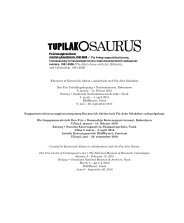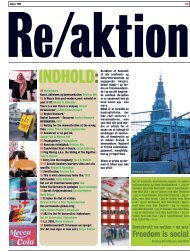tupilakosaurus - Print matters!
tupilakosaurus - Print matters!
tupilakosaurus - Print matters!
You also want an ePaper? Increase the reach of your titles
YUMPU automatically turns print PDFs into web optimized ePapers that Google loves.
gitsut. 1990<br />
tassalu assiliiviup saaniittup tunuaniittullu<br />
akornannut. Taamaattumik Arketulli<br />
pissusiviusimasunik ujartuigaanni tassaavoq<br />
aallaqqaaterpiaaniit avissimanermik<br />
taassuminnga ujartuinissaq. Assiliivik<br />
putuaraannalik taassumalu immikkuullarissumik<br />
pilersitai tassaapput tunngaviusumik<br />
ileqqupalaamik suliarinnikkusunneq<br />
qaangeerusunnerlu; misiliineq<br />
soorunami allamik takutitsisoq: Akuneqarluni,<br />
affarmik eskimuujulluni affarmillu<br />
europamiuulluni, naggueqarnermik suliarinninneq.<br />
Assilineqartoq immikkuullarissoq tassa<br />
Kalaallit Nunaat, maannakkorpiaanngitsoq<br />
toqqaannanngitsumillu, kisiannili<br />
sammisaq imaluunniit assi – soorlu nunasiaataanerup<br />
oqaluttuassartaa, oqaluttuatoqqat,<br />
iluanaarutit, nuannariinnarlugu<br />
eqqaamassutissiat, misissugassatut<br />
saqqummersitassatulluunniit pissarsiat.<br />
Immikkuullarissuseq minnerunngitsumik<br />
erserpoq nunasiaatillit eqqumiitsulianik<br />
aallarussuisimanerannik malinninnissamik<br />
takorluuineq assiliissutip sammivilerneragut<br />
assiliinikkullu, misiliinerit<br />
amerlaqisut akuliussuunnerisigut. Assilissat<br />
erseriartuaartut sinnattutullusooq ittut<br />
takutippaat ingerlaaseq inerneqanngitsoq<br />
immaqalu inerneqanngisaannartussaq,<br />
immikkuullarissutaallu assimi anginerusumiippoq<br />
atortorissaarutit namminneq<br />
atugaasa iluanniilluni. Ilumummi eqqortumik<br />
kusanartuliaassagaluarpoq paasisinnaagaluaraanni<br />
pilersillugulu imminnut<br />
ataqatigiinngissorisinnaasat amerlaqisut<br />
– kusanartulerinerit, inuit ataasiakkaat<br />
politikkillu – imminnut ataqatigiinnerat.<br />
Taakku tamarmik eqqartuussiniarpalaaqaat.<br />
Usi aamma taakkununnga ilaavoq<br />
immikkuullarissusermi paasiniaruminaannerpaaq,<br />
taamaattorli assilissat taakku<br />
ingerlateqqissinnaasaat, tassalu inunnut<br />
qamanilu pigisaannut oqaluttuarneq. Erseqqilluinnarportaaq<br />
taamaaliorneq Arkep<br />
piginnaasaanut ilaasoq, assilisamigummi<br />
eqqarsaatigisimanngisaannarunarpaa<br />
assiliaannaanissaat. Akerlianik paasisitsiniuterpiatut<br />
atorniarpai siunertanut,<br />
saqqummiussanut peqataanernullu nammineq<br />
allallu akunnerminniittunut.<br />
Erik Gant<br />
(allakkiamit “Det Arketypiske/ Pia Arke”<br />
tigusaq, KATALOG, upernaakkut 1996)<br />
Pia Arke. Untitled. 1990<br />
The main idea apparently is to<br />
adapt photographic implements<br />
to human dimensions; to strip<br />
the camera of mechanical and<br />
electronic gadgetry, substituting<br />
that with the human being inside.<br />
And, through negative size and<br />
exposure time (15 min. up to several<br />
hours), to try to get the basic,<br />
one-on-one character of photography<br />
to embrace the photographer<br />
as well. The positive picture, which<br />
the big negative throws back into<br />
the murky chamber, plus the long<br />
exposure time, provide the option<br />
of steering the input of light onto<br />
different regions of the picture. The<br />
photographer can, in the most tangible<br />
sense, put her own fingerprint<br />
or handprint on the picture.<br />
The way I see it, and maybe in<br />
spite of these impressions and<br />
manipulations, this is in high<br />
degree the embodiment of pure<br />
photography; a direct and immediate<br />
contact with the medium which<br />
generates the idea of the pinhole<br />
camera and manifests itself again<br />
in the paper prints. Pia Arke’s most<br />
widely circulated picture, a view of<br />
a South Greenland fjord with its<br />
peculiar rock formations, is a scene<br />
I grew up with, so to speak, on my<br />
retina. More than 20 years have<br />
passed since I last saw that view<br />
from our mutual childhood home.<br />
And when I compare the two pictures,<br />
my own faded retinal image<br />
and my sister’s photograph from<br />
1990, it strikes me that the former<br />
is far sharper, filled with Kodacolorlike<br />
nuances and transitions that<br />
have no equivalence in the latter.<br />
But Arke’s photography also makes<br />
me realize what has been happening<br />
to this place: closed down,<br />
robbed of its dimensions, haunted,<br />
covered with film.<br />
The surprising and beautiful thing<br />
about these pictures springs, I believe,<br />
straight from their character<br />
as prints or impressions, a character<br />
allowed to emerge through<br />
the veil without being forced aside<br />
by an all-too-high degree of sharp<br />
similarity, and without the pictures<br />
posing as indices to truths other<br />
than their own.<br />
Photography from the beginning<br />
has been divided, so to speak,<br />
between what is in front of the<br />
camera and what is behind it.<br />
Therefore, like Arke, when you look<br />
back at the original, it is tantamount<br />
to going back to the original<br />
division. Arke’s camera obscura,<br />
and its Arketypical fruits, are an<br />
attempt to treat and overcome a basic<br />
problem – an attempt at which,<br />
of course, again shows something<br />
else: the acculturation of a mongrel<br />
of half-Eskimo, half-European<br />
origin.<br />
The Arketypical motif is really always<br />
Greenland. Not immediately<br />
or directly, but still the subliminal<br />
subject – as colonial history, myth,<br />
prey, trophy, study or exhibition<br />
object. The Arketypical lies not<br />
least in a dream of emulating the<br />
typical tricks of colonial adaptation<br />
by aiming at objectivity and unbiased<br />
reportage, cross-culturization<br />
and a comprehensive sampling of<br />
reality. The dreamlike quality of<br />
the images that slowly emerge indicates<br />
that we are dealing here with<br />
an unfinished and maybe unfinishable<br />
process, and that the Arketypical<br />
makes up part of a larger<br />
picture, enveloped by the apparatus<br />
used to record that never-never<br />
scene. Whatever, it will be no mean<br />
work of art to expose the connections<br />
between the many apparently<br />
irreconcilable – aesthetic, personal,<br />
political – of the Pia Arke-typing.<br />
All of this is highly process-oriented.<br />
Which, by the way, seems to<br />
be the part of Arketyping that is<br />
toughest to analyze, having to do<br />
with the ability of these pictures<br />
to communicate, to talk to people<br />
or something inside them. This<br />
quite clearly also has something<br />
to do with Arke’s abilities in the<br />
same direction, since her pictures,<br />
as far as I know, were never really<br />
intended to speak for themselves.<br />
On the contrary they are meant to<br />
function as a medium for all manner<br />
of intentions, messages and<br />
engagements in the relationship<br />
between herself and others.<br />
Erik Gant<br />
(excerpt from the article “The<br />
‘Arke’typical/Pia Arke,”<br />
KATALOG, Spring 1996)<br />
55




